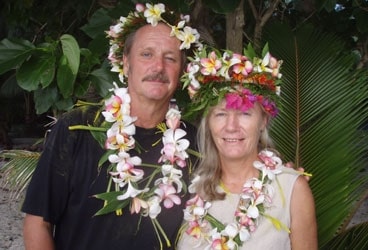
RHLamotrek368
We dropped anchor just off the village of Lamotrek. Even though we were exhausted, custom demanded that we row to shore and introduce ourselves to the chief. A large man waved us in towards one of a row of towering, thatched boathouses. Thirty men in loincloths sat around a breadfruit log adzing out the rough shape of a Micronesian proa. Francis introduced himself in perfect English. I explained I wanted to see the chief to offer a small gift and ask his permission to anchor in the lagoon. Francis translated. The men nodded in approval; it is the proper way.
I ceremoniously offered the elderly Chief Joseph a big plait of tobacco and a box of matches. That went down well because they had not had seen a supply ship in three months and were virtually out of everything. Besides matches, he found ten shiny fish hooks in the box. Puzzled, he asked Francis to get an explanation. I said it seems an island man is always short of two important things, dry matches and a good sharp hook. He smiled, turned to Francis and said, “Tell them they are welcome here.”
Francis laid lush floral wreaths on our heads, offered us woven baskets overflowing with taro and fried breadfruit, a cup of raw clams, and sent an army of children off in search of the sweetest drinking coconuts.
The genders do not mix in public except for church and festivals. The men have boats to build, fish traps to set. The women have cooking fires to tend, taro patches to weed, and lava-lavas to weave. The segregation is so strict that if a woman inadvertently comes upon a group of men she must immediately drop to a crouch and shuffle past, ensuring she is never higher than a male relative. But the arrival of a “yachtboat” is a big event; excitement erodes discipline. Scores of bare breasted girls and women hung coyly back in the coconut trees, their eyes riveted on Diana.
The moment Diana wandered from the boathouse she was spirited away by the women. Her normal shyness was completely overcome by her fascination with the fine traditional weaving. She disappeared into the smoky huts, discussing back-strap looms, warp and weft tensions, dyes, native materials, traditional patterns, and their meanings. The lava-lava is the female costume de rigueur and still a form of currency. In spite of the enormous efforts required to weave one, Diana was given two.
In return, the next day we brought to shore much needed medicines, rice, sugar, flour, and oil. When Diana gave one woman a can of meat the woman said, “Thank you. Our dogs are still too skinny to eat.”
Diana arched her brow skeptically when I explained that my daily duties were to attach myself to whichever of the five boathouses I chose, contribute something to the building or repair of the very cool proas, and never miss either the 3 o’clock nor the 6 o’clock mandatory tuba (coconut beer) drinking sessions. “Di, when in Rome,” I explained without cracking a smile.
Messing about with boats, discussing weighty topics beneath the stars, a little nip to relieve the stress–but there are no little nips here. There is but one cup. To nurture your drink leaves the next man in the circle waiting. By the end of the first week it was clear that I could not keep the pace. One night I ever so cleverly arrived late hoping to curtail my ration of the sour fluid. The circle’s elder held up four fingers to indicate that was how many cups ahead of me they were. I had to down the four before they would touch another drop. Men drink together he explained, that means cup for cup. I wondered if this custom indicated an anthropological link with Australia.
The fishermen had long since run out of gasoline, and the few outboards lay useless beneath the coconut trees. I took a dingy load of men outside the reef for a day of spear-fishing. The strong winds made it unsafe for even a “13 turtle” canoe to venture out into the rough but productive offshore fishing grounds. I loaded the Roger Henry with enormous men and set out trolling with lures made from coconut fronds. Celestine, a certified Star Path Navigator, never relinquished the tiller. He beamed in delight learning how a modern boat tacks and jibes. He loved shouting in English, “Ready about?” The mahi-mahi and wahoo we caught fed the northern half of the island.
I fixed spear guns and taught the men how to stitch modern sail material. Di, with her entourage of sweet children, wandered from hut to hut photographing the precious lava-lavas, learning to make taro sweets, and the many ways to prepare breadfruit.
After church on Sunday we used reverence as an excuse to stay onboard and catch up with each other. Navigating our way through complex cultural differences was exhausting. But we agreed that it was a unique privilege to be taken into the hearts and homes of these amazing island people. We decided to delay our departure for Guam.
For more photos of the Simon’s stopover in Lamotrek Click Here








